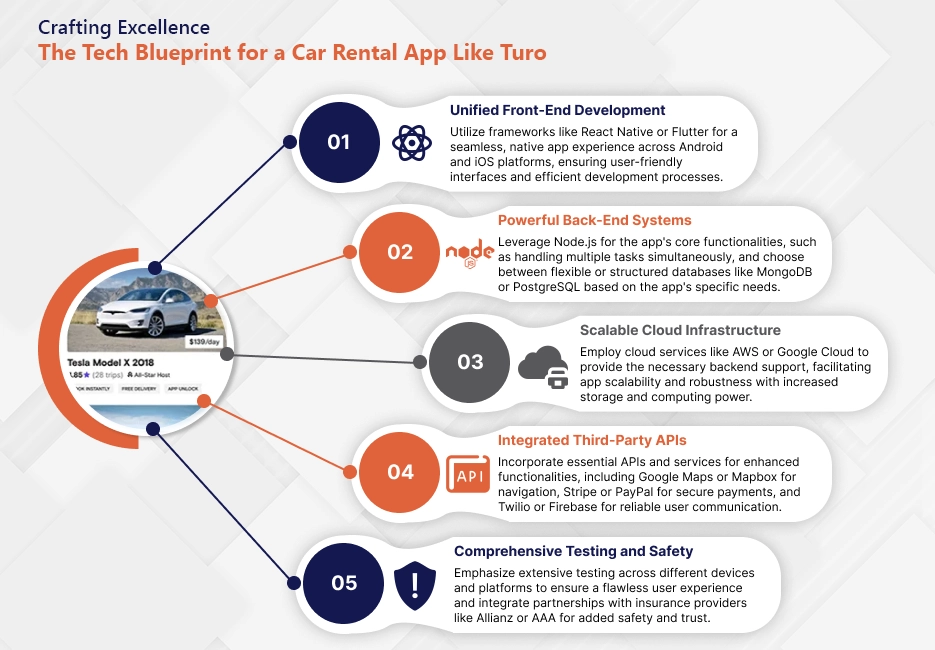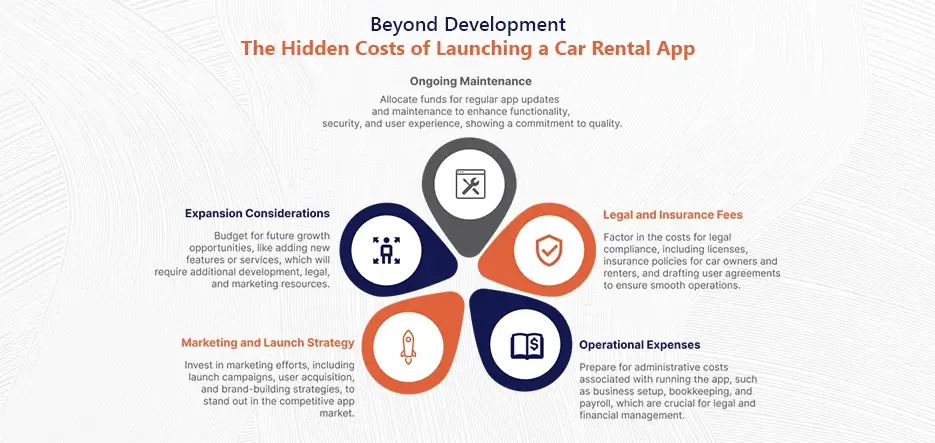Table of Contents
In our fast-moving world, how we get around constantly changes. Thanks to tech, car rental apps are now a top pick for easy and flexible travel. Car rental apps like Turo are changing the game. They link car owners with people who want to rent a car. This part talks about how car rental apps are growing, why it’s important to guess costs right when making an app, and why Turo is a great example for those thinking about making an app or investing in one.
In the last ten years, more people have wanted services right when they ask for them. A study says the global car rental market will hit $124.56 billion by 2027. Apps like Turo are leading this change. They let you rent cars from car owners, skipping usual rental places. This makes renting a car easier and more personal.
These apps have won over many users. Travelers looking for a good deal on rentals and people needing a car for a short time love them. This success has made many business people and companies making apps on demand want to enter this market.

Why Guessing Costs Right Matters for Developers and Investors
Making a car rental app costs design, production, maintenance, and marketing money. Developers and investors need to guess these costs well. This means they can plan their cash well, avoiding surprises that could mess up the project.
Knowing the money side helps investors decide whether to join. It lets developers plan the project well, ensuring the app works great without cutting corners. A good guess at costs is key for a successful app project. It lays the groundwork for smart planning and doing the job right.
Learning from Turo’s story helps developers and investors see how to grow their apps, manage many users, and deal with laws. So, Turo is a perfect study for anyone wanting to start in car rentals or an on demand app development company hoping to do as well as Turo.
To wrap up, car rental apps like Turo make travel more about what users want, offering more freedom. Guessing costs well is key to creating and keeping these apps successful. It guides developers and investors through the app-making process. By looking at Turo’s success, those wanting to make a car rental app can learn a lot about meeting today’s travel needs.
Understanding the Car Rental App Market
In our digital era, the car rental scene is transforming, thanks to tech advancements and shifts in people’s wants. Car rental apps like Turo are leading this change, which redefine car renting with more choice and ease. This section dives into key stats and shows how these apps reshape the industry.
First, car rental apps are catching on big time. A report shows the global car rental market is rising, thanks to digital platforms. Car rental apps like Turo are a big hit with a global reach.
The ‘Car Rentals’ segment within the U.S. shared mobility market is projected to steadily increase its user base by 3.2 million users (a 6.56 percent increase) from 2024 to 2028. This period marks the eighth year of consecutive growth for the segment, culminating in an estimated peak of 51.95 million users by 2028.
These numbers show how popular these apps are and point to a change in how we choose to get around, favoring convenience and access.

The Revolution Brought by Apps Like Turo
Car Rental Apps Like Turo have flipped the car rental industry. They use tech to link car owners with renters, offering a slick experience. This peer-to-peer approach has many pluses:
- There’s a huge variety of cars, from daily drives to luxury wheels, meeting all sorts of needs and tastes.
- Renting a car is easier and clearer than ever. With a few taps on a smartphone, users can pick, compare, and book cars.
- Car Rental Apps Like Turo make renting more personal. Car owners set their rules and prices, making things more flexible and building trust for repeat business.
Turo’s massive effect on the market pushes old-school rental services to get creative and tech-up. We’re seeing more businesses get into enterprise mobile application development to keep up, whether by crafting apps or enhancing online services.
The Role of Enterprise Mobile Application Development
The boom in rental car apps like Turo highlights the crucial role of enterprise mobile application development in transport. Companies are pushing hard to create easy and appealing apps for users. This push comes from fresh faces like Turo and established names in car rental.
Big rental firms are pouring money into app development to streamline bookings and add features like mobile check-in. This digital shift aims to boost customer satisfaction and keep up with app-based competitors.
Newcomers like the Hopper car rental app are also innovating with tech, using smart algorithms to snag users the best deals. This shows the broad impact of tech on how we rent cars and how the car rental business evolves.
In wrapping up, the car rental app market is fast changing, driven by a demand for convenient, flexible services tailored to individual needs. An app like Turo is at the forefront, disrupting traditional models and setting new benchmarks for the customer experience. As this market expands, the focus on enterprise mobile application development will be key in defining the future of car rentals, with companies aiming to innovate and keep pace with our digital world.
Car rental apps have transformed the way people access transportation, providing a convenient and flexible alternative to traditional car rental services. – Daisy Grace
Core Features of Car Rental Apps Like Turo
In the world of getting around, car rental apps like Turo have shaken things up. They’ve made it easy for car owners and people wanting to rent to connect. The big win of these platforms comes down to some key features that make everything about renting or listing a car straightforward and safe. These bits are super important for companies focused on creating apps, whether crafting the next big thing in iOS apps or diving into carpooling app development. Let’s dig into what makes these features stand out:
Start your Journey with A3Logics to Create a Leading Car Rental App Today!
Finding and Choosing a Car to Rent
- Easy-to-Use Search Filters: The beauty of Car Rental Apps Like Turo lies in their simple search tools. Want an SUV in Los Angeles for under $50 a day? The filters help you find exactly that, fast. This ease of use is a game-changer for folks looking to rent.
- Smooth Booking Steps: Once you pick a car, checking it out and booking it is a breeze. Clear details, lots of photos, and straight-up info on pricing mean no surprises later.
Setting Up and Managing Your Profile
- Your Own Space: You set up your profile right off the bat. This is where you can keep track of your rentals, pick favorites, and even get suggestions tailored just for you. Car owners use this space to list their rides, manage bookings, and see their earnings.
- Keeping Things Safe: Trust is huge when renting from or to a stranger. That’s why there’s a big focus on safety. Think verified profiles, secure chats, and a system where everyone can rate and review their experiences. Plus, there’s often insurance to cover the what-ifs.
Handling Money and Staying Safe
- Payments Without the Hassle: The way payments are handled is top-notch. Secure payment methods mean everyone’s info stays safe, and the process is slick for users.
- Keeping Everything Secure: With top-tier security measures in place, everyone can rest easy knowing their transactions are protected against the bad stuff.
The Power of Reviews and Ratings
- Feedback Matters: Reviews and ratings are the heart of the system. They help renters make informed choices and give owners feedback on what’s working (or not). Good reviews can mean more business for car owners.
- Building Trust in the App: A platform with positive reviews and high ratings draws in more users. It shows the app is reliable and that people are having great experiences.
To wrap up, the success of car rental apps like Turo comes down to focusing on what users need and making sure everything runs smoothly and safely. For iOS app development companies and those jumping into carpooling app development, nailing these features is key. As we all look for more flexible ways to get around, these elements will play a huge role in shaping how we think about car rental.
Tech Stack: Building a Car Rental App
When setting up a car rental app like Turo, picking the right tech is a big deal. It affects how well the app works, how it can grow, and how people feel using it. Here, we’re diving into the essential tech, services, and third-party tools for a solid and scalable car rental app. This is key info for those making apps, especially if they’re considering Car Rental Apps Like Turo.

Tech for Users to See and Use
The part of the app everyone sees and uses needs to be slick and easy to navigate. This is true whether it’s on a phone or a web browser. Developers often use React Native or Flutter to make apps that feel native to Android or iOS from just one set of code, saving time and money.
React Native, for example, is great for a Turo-like app because it’s packed with components and lets the app use phone features like GPS or cameras. For web bits, Angular or Vue.js can ensure the site works well on all screens, big or small.
Behind-the-Scenes Tech
The backend is where the app’s heartbeats. It handles logins, stores data, and does all the heavy lifting. Node.js is a favorite for these tasks because it can handle many things simultaneously, perfect for a busy app like a car rental service.
Choosing a database like MongoDB or PostgreSQL depends on the app’s needs—flexibility and growth or complex data handling. Cloud services like AWS or Google Cloud Platform are go-to choices for keeping everything running smoothly in the background, offering the power and space the app needs to grow.
Essential APIs and Helpers
To add features without building everything from scratch, apps tap into APIs and services for maps, payments, messages, and more. For a car rental app:
- Maps and Navigation: Google Maps or Mapbox APIs can help users find cars or get to their rental.
- Payments: Stripe, PayPal, or Braintree make paying or getting paid easy and safe.
- Messaging: Twilio or Firebase keeps renters and owners connected.
- Safety First: Integrations with Allianz or AAA can bring in insurance and help on the road directly in the app.
Testing the app on different devices and systems is crucial for a smooth experience for everyone. An iPhone emulator can help check the iOS part of the app without needing a bunch of iPhones lying around.
In short, a car rental app like Turo needs a thoughtful mix of front-end and back-end tech, plus smart integrations. For a mobile app consulting company looking to make a splash in car rentals, these are the building blocks for an app that stands out.
Cost Factors in Developing Car Rental Apps
Creating car rental apps like Turo means juggling a bunch of costs, from design to adding special services. Getting a handle on these costs is key for businesses eyeing the car rental app market. This rundown will help Android app development companies understand what goes into budgeting for such a project. Let’s break down the main costs of making an app that hits the mark.
Designing for a Great Experience
- Why Good Design Matters: For car rental apps, making things easy and intuitive for users is huge. A slick design means people can zip around the app, getting what they need without fuss. Great design isn’t just nice; it’s a must for keeping users happy and returning.
- What Design Might Cost: Design costs can vary widely. They all depend on how complex your app is, who’s designing it, and where they’re based. Costs can range from a few thousand bucks for the basics to much more for a top-notch look and feel.
Choosing the Right Development Path
- Platform Choices: Your budget will affect your iOS, Android, or both choices. iOS is neat but limits you to iPhone users. Android gets you a broader audience but can be wilder because of all the different devices. Cross platform app development can save time and money using one codebase for iOS and Android, but it might not feel as polished as native apps.
- Impact on Cost: Your platform pick has a direct effect on cost. Cross-platform development could look cheaper at first glance, but think about the long run and how it might affect user happiness and app smoothness.
The Backbone: Backend and Database
- Why Server Stuff Matters: The backend and database are the heart of your app, dealing with data, transactions, and more. Your choices here affect how well your app runs and how much it’ll cost you as it grows.
- Server Costs: Server costs might be lower for a simple app. But those costs will increase as your app grows and serves more users. It’s worth investing in a strong backend early on to avoid headaches later.
Integrating Extras
- Adding Cool Features: Payment systems, maps, and other tools make your app more useful and add to your costs. These extras might have subscription fees or charges per use.
- Smoothing Things Out with Integration Platforms: Using an enterprise application integration platform can make it easier to connect all these extras, even if it adds a bit to your development bill. It’s often worth it for the headaches it saves down the line.
Ultimately, the price tag for creating a car rental app like Turo covers design, development, backend, and third-party service costs. A custom mobile app development company diving into this area must carefully weigh these factors. The goal is to balance spending with keeping the app top-notch, ensuring it stands out in a crowded market.
Additional Costs to Consider
When diving into car rental apps like Turo, there’s much more to consider than just building the app. After the app looks great and works like a charm, it’s time to consider other key expenses to ensure it thrives in the competitive app space. These include marketing and launch strategies, regular maintenance, and legal fees. Let’s unpack these costs, which are vital for any top mobile app development companies in the USA or anywhere aiming to launch the next best car rental apps like Turo.

Keeping the App in the Top Shape
Once your app is live, it’s not just ‘set and forget.’ Regular maintenance and updates are needed to keep it running smoothly and safely. This means squashing bugs, updating it for new OS versions, and adding features users want. Keeping your app fresh shows users you’re committed to providing a great experience.
Costs for upkeep can vary, but consider setting aside money for ongoing development work. Top developers offer maintenance plans that update the app with the latest tech and security measures.
Navigating the Legal Landscape
There’s also the legal side to consider. This includes licenses, insurance, and ensuring you’re on the right side of local and international laws. For peer-to-peer rental apps, it’s crucial to have solid insurance for both car owners and renters. Plus, you’ll need legal help to craft user agreements and privacy policies.
Don’t forget about the admin side of things—like setting up your business, bookkeeping, and payroll. While these costs can add up, they’re essential for running your app legally and smoothly.
Thinking Bigger
Eyeing expansions, like adding a SpotHero-like Parking App feature for parking, can open new revenue channels. Yet, this also means more development, legal, and marketing expenses. Planning and budget allocation become even more crucial.
Launching a successful car rental app involves much more than the initial build. Marketing, maintenance, and legal fees are all part of the equation. Being mindful of these can set you up for success, ensuring your app launches and lasts in the busy market.
Estimating the Total Cost
Breaking Down the Costs by Features
To figure out the total cost, start with what features your app needs. This could be anything from setting up user accounts, showing car listings, adding search and filter options, managing bookings, handling payments, and letting users leave reviews. Here’s a bit more on what some of these might involve:
- User Registration and Profiles: This part is all about making a secure way for users to sign up and create profiles. You might also want to link it with social media.
- Vehicle Listings: You’ll need a way for car owners to share info about their cars, including photos and when they’re available.
- Search and Filters: With handy search tools, users should easily find the car that fits their needs.
- Booking System: This includes picking dates and booking cars, possibly with a calendar view.
- Payment Processing: You’ll integrate a way to handle payments safely between users.
- Reviews and Ratings: A feature for feedback on rentals to build trust and improve services.
Adding more sophisticated features to your custom app development services, like real-time tracking or chat functions, will increase the price due to the extra complexity and expertise needed.
DIY vs. Professional Development Team
You have two options: build it yourself or hire a pro team. Both have their ups and downs.
- DIY Approach: If you have the skills, you might tackle the project yourself. It could seem cheaper initially but don’t forget the steep learning curve and time investment needed for areas outside your expertise.
- Hiring a Development Team: This gets you a crew of experts, each focused on their part of the app, from design to testing. While it might cost more upfront, you’ll likely get a sleeker app and a smoother launch, potentially saving money and stress in the long run.
Choosing between DIY or hiring mobile app developers affects not just your budget but also the quality and timeline of your app. Experienced teams can also offer insights and help dodge common pitfalls, which can be invaluable.
Creating an app to rival Turo or become the top ridesharing app hit is no small feat. It demands a close look at the costs for each feature, plus a strategic choice about how to tackle the build.
Book 30 Minutes Free Consultations with A3Logics Experts to Start Your App Journey Today!
Conclusion
Getting your cost estimates right is foundational for any app project. It helps set realistic budgets, efficient resource use, and scalability planning. Every choice, from design and user experience to tech stacks and third-party integrations, affects costs. Deciding between developing specifically for iOS and Android or a cross-platform option like partnering with a Flutter app development company in the USA has big budget implications.
Don’t forget about marketing, legal, and admin costs. Though often overlooked in initial budgeting, these are critical for your app’s launch and legal operation.
The popularity of Car Rental Apps Like Turo shows a high demand for digital solutions that provide users with convenience. This demand allows developers to innovate and grab their market share with unique offerings.
See challenges as chances to grow. Connect with other developers, listen to your target audience, and refine your app based on real use and feedback.
Collaborate with A3Logics, apply the insights from this guide, and step confidently into app development.
The path to app development is full of learning and potential impact. Don’t let the process intimidate you. Proper planning, a great team, and the right resources can lead to an app that shines in the digital world. Begin small, aim high, and chase your app development dreams passionately. Your future users are out there waiting.
FAQs
Going Solo or Building a Team?
Crafting a car rental app is complex, often requiring a diverse team skilled in design, development, QA, and project management. While individuals with strong development backgrounds might kickstart the project, a team approach ensures comprehensive execution and quicker progress. Collaborating brings varied skills and insights, enriching the app’s quality and appeal.
What Are the Main Revenue Streams for Car Rental Apps?
Car rental apps like Turo earn income from several sources, including transaction fees, premium listings, and additional services. Transaction fees are a staple, and charging owners a fee per rental helps sustain the platform. Premium listings and insurance offerings can boost revenue. Diverse income strategies support a stable business model.
How Long Does It Take to Develop a Fully Functional Car Rental App?
Creating a fully functional car rental app takes varying amounts of time, often months to over a year, depending on the app’s complexity, feature count, and team size. Opting for an MVP can speed up the launch, allowing real-user feedback to refine future updates.
Are There Any Legal Considerations I Should Be Aware of Before Launching My App?
Launching a car rental app involves legal homework, including adhering to local and international laws, data protection standards, and insurance mandates. Understanding your operational, legal framework is crucial. Legal counsel can guide you through the maze of regulations, ensuring your app meets all legal expectations and protects users effectively.
How Can I Ensure the Security of Transactions in My Car Rental App?
Transaction security is crucial for any app handling money. Standard encryption, secure payment gateways, and regular audits protect financial data. Adhering to PCI DSS and considering extra security steps like two-factor authentication fortifies user trust. Choosing reliable payment processors and vigilant security monitoring are key to a secure platform.






